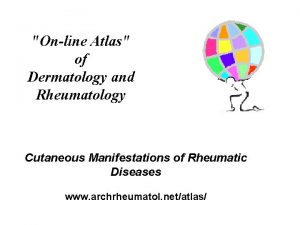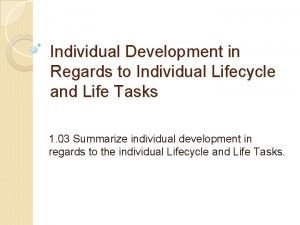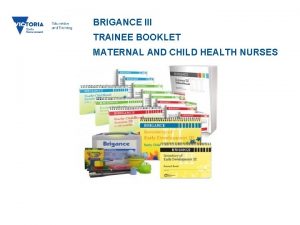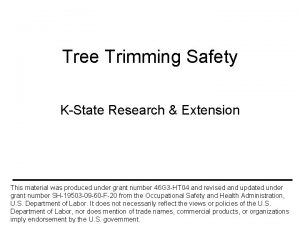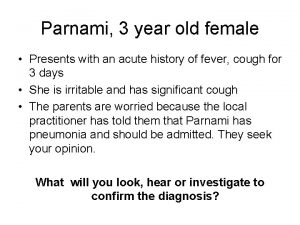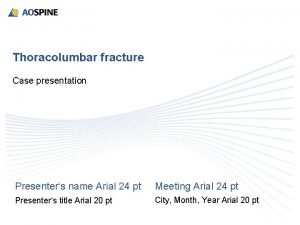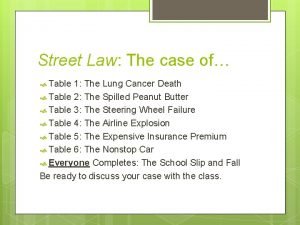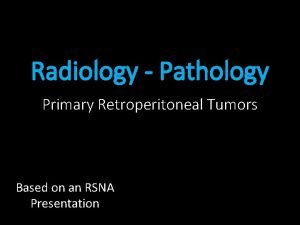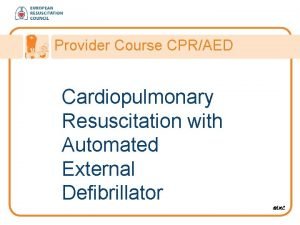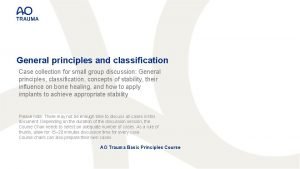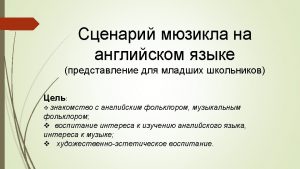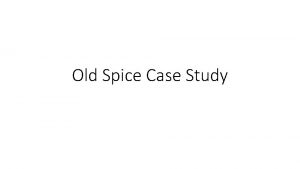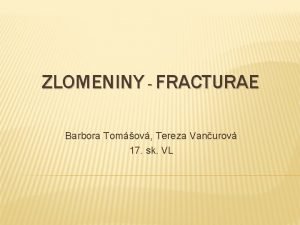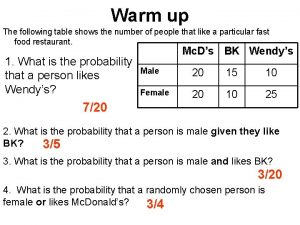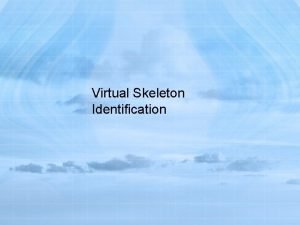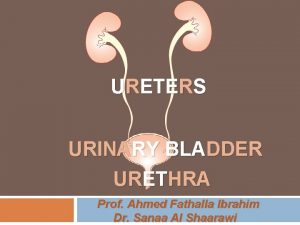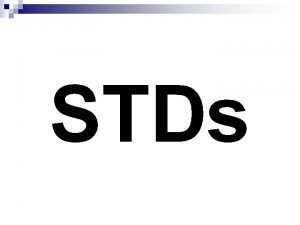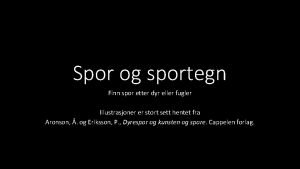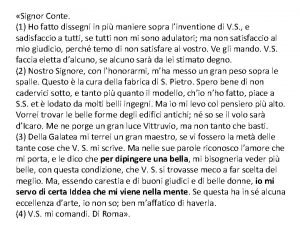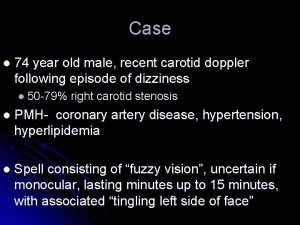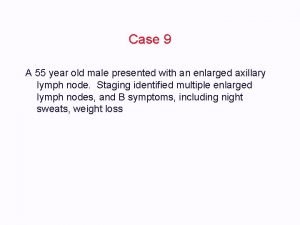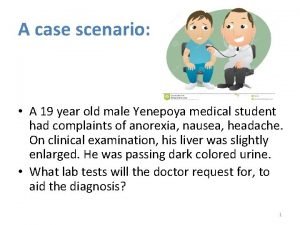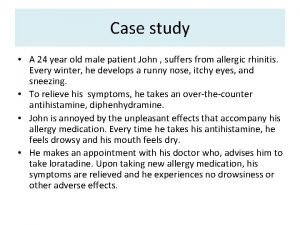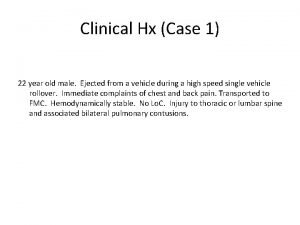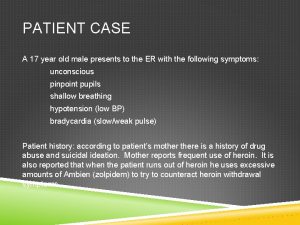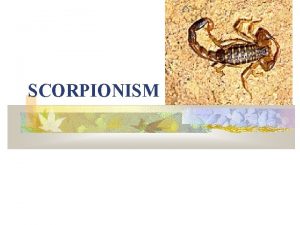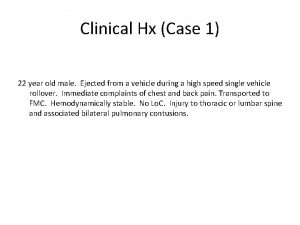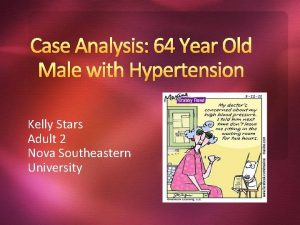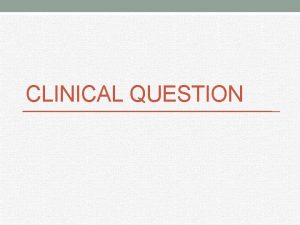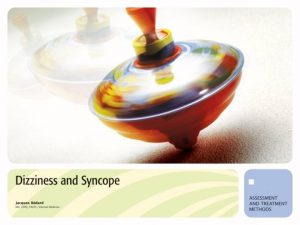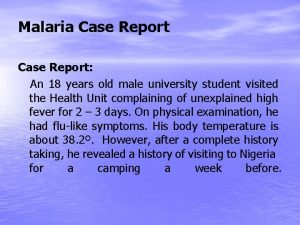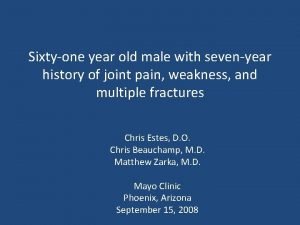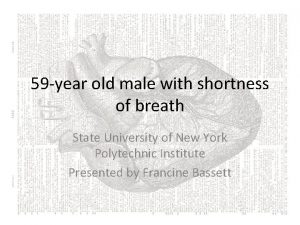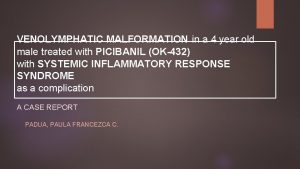Case 1 50 year old male with no












































































- Slides: 76


Case 1 • 50 year old male with no significant medical background presents with one year history of swelling in the left inguinal area.

• Further history ? • What are your DD? ? • Risk factors ? ?

• How will you differentiate between direct and indirect hernia on physical examination ?

• What are the bounderies of hesselbachs triangle ?


• Boundaries and content of the inguinal canal ?


How will you manage this patient ? ?

• Patient refused surgical intervention and he is asking about the possible complications of inguinal hernia …

• Patient refused surgical intervention , 2 months later he presents to the ED with 3 hours history of fever ; painful irreducible right inguinal swelling ; vomiting and constipation

• What is your diagnosis ? • How will you manage this patient?

• 40 year old patient presents with 2 months history of central abdominal swelling. • Diagnosis? • How will you manage this patient ?

Case 2 • 35 year old male patient was hit by his wife on the head by a metallic pan ; lost consciousness and was brought by EMS to the ED. • As a trauma team leader what will you do before the patient arrives to ED ? • How will you approach this patient ?

Primary survey A: C-spine collar ON Not responding Mouth –full of blood What will you do next ? B: equal air entry bilaterally , SPO 2 100% C: BP 80/60 ; HR 60

• D : GCS: 6 E-1 V-1 M-4 Right pupil was dilated E: No other injuries identified

Secondary survey • Normal • What will you do next ?



• What are the signs of raised ICP?

• How will you mainatain the cerbral perfusion pressure ?

Case 3 • 25 year old man was stabbed in the chest while he was walking in the street. He was brought to ED by EMS. What will you do next ?

• A: Patent Will you keep the C-collar in place ? B: Sp. O 2 : 80% ; reduced air entry on the right side of the chest What will you do next ?

• Where will you place your ICD ? • What will you do next ?

• A: Patient is not responding What will you do ? • BP dropped to 80/40 ; what will you do ? • Type of blood ? • What will you do next ?


• Patient dropped his BP again to 70/40 mm. Hg ; what will you look for ? • What is the definition of massive hemothorax ?

• Chest tube drained 2 L of blood what will you do next ?

Case 4 • 24 year old man involved in a head on collision was brough by EMS to the ED with C collar and backboard in palce. • What will you do next ?

Primary survey • A: Patent ; C-Collar is in palce • B: Sp. O 2 is 80 % ; RR 28 ; absent air entry on the left side of the chest • What will you do next ?


Primary survey • B: Sp. O 2 : 96% ; RR 18 • C: HR 110 bpm , BP 110/90 mm. Hg • D: GCS 15 , reactive pupils

• E: Scalp laceration ; active bleeding What will you do next ?

What will you do next ? ?

• What are the signs of urethral injury ?

Secondary survey • Normal • What do you want to do now ?


What will you do next ?

• Patient was shifted to the ICU ; 3 hours later , • BP : 80/40 mm. Hg • Hb dropped from 12 to 6 ( required 6 units of PRBC). What will you do ?

Case 5 • 30 year old man ; fell from a hight of 3 meters while he was cleaning the roof of his house ; brought by EMS with C collar and backboard in place. • What will you do next ?

Primary survey • A: Patent , C-collar is in place • B: SPO 2 84% ; RR 20 • C: BP 110/80 ; HR 100 • D: GCS : 14 ; pupils are reactive • E: multiple abrassions in the abdomen

What do you want to do next ?

Secondary survey • Normal • What do want to do next ?

Free fluid with no solid organ injury What injuries will u expect & what should you do next ?

Case 6 • 32 year old presents with 3 weeks history of perianal pain. • What further history would you like to obtain ? • DD?

Examination • What is you diagnosis • Will you do PR examination • What are your management options

Mangement • Acute fissures: -Stool softeners (ispaghula ) -0. 5% diltiazem -Nitrates (glyceryl trinitrate 0. 2– 0. 5%) as a cream applied 12 -hourly to the anal canal. -Botulinum toxin injection - temporarily paralyze sphincter -5% lignocaine

Surgical options : • Anal skin advancement flap • Lateral (internal) anal sphincterotomy.

Case 7 • 35 year old man presents with 2 week history of perianal discharge Further history ? DD?

Examination

• What are the different types of perianal fistula ?

• What is goodsall’s rule?

• Gold standard investigation to diagnose perianal fistulas ?


Schematic depiction of a fistulotomy

Seton placement


Case 8 • 35 year old man presents with 1 month history of dragging /aching sensation on defication associated with on an off bleeding. • Further history ? • DD?

Diagnosis?

• What are the 3 three anal cushions correspond to 3 terminal branches of the superior rectal artery? • Haemorrhoids classification ? • Haemorrhoids complication ?

Non-operative management • Treat constipation with a high-fiber diet / bulk laxatives / stool softeners. • Barron’s rubber band ligation [most effective] • Submucosal injection of sclerosant • Heat application by infrared photocoagulation.

Operative Management 1. Hemorrhoidectomy: the wound can be left open (Milligan. Morgan) or can be closed. 1. Stapled hemorrhoidopexy: used extensively for symptomatic 2 nd degree, most of 3 rd & 4 th degree.

Choice of treatment: • First degree: avoid constipation and straining • Second degree: conservative, banding, sclerotherapy, hemorrhoidectomy. • Third degree: hemorrhoidectomy if symptomatic • Fourth degree: thrombosed piles treated conservatively ± interval hemorrhoidectomy

Case 9 • 30 year old patient presents with 5 days history of perianal swelling ; which is very painful and is discharging pus. • What is your diagnosis ?


Case 10 • 2 year old girl presents to the ED with 2 hours history of abdominal pain and vomiting Further history ? DD?

Examination • Right lower quadrant that is scaphoid (empty; Dance's sign) • Palpable "sausage-shaped" mass in the right mid or upper abdomen What is your diagnosis?

What do you call this sign

• What are the mangement options for intussusception?

Case 11 • 3 year old boy presents with 3 hours history of painful irreducible left inguinal mass. • What is you diagnosis • How will you manage this patient

Case 12 • 7 weeks old infant presents with 4 hours history of nonbilious projectile vomiting , as per the mother the infant demans to be fed soon afterwards ( hungry vomiter). • What are you DD ?

Examination What is your diagnosis ? Investigations ?


• What is the most common electrolyte abnormality ? • How will you manage this patient ?


• Thank you
 Emt chapter 24 trauma overview
Emt chapter 24 trauma overview Best worst and average case
Best worst and average case School leaver poems
School leaver poems Resting heart rate for women
Resting heart rate for women How does the narrator convey a mixed attitude toward gatsby
How does the narrator convey a mixed attitude toward gatsby 42 year old woman
42 year old woman Sample iep massachusetts
Sample iep massachusetts Average height of a 3 year old in centimeters
Average height of a 3 year old in centimeters 9-year-old physical development
9-year-old physical development Eight year old hyphen
Eight year old hyphen Average weight for 8-year-old boy
Average weight for 8-year-old boy Weight for an 8 year old girl
Weight for an 8 year old girl 9-year-old physical development
9-year-old physical development Brigance scoring chart 3 year-old
Brigance scoring chart 3 year-old Interpreting brigance scores
Interpreting brigance scores One year old marcus turns away in disgust of a bitter
One year old marcus turns away in disgust of a bitter Adhd in 3 year old
Adhd in 3 year old Five year old tammy mistakenly believes that her short
Five year old tammy mistakenly believes that her short Josef a high school student tells his therapist
Josef a high school student tells his therapist 54 year old tree trimming accident
54 year old tree trimming accident Energy of four forces quick check
Energy of four forces quick check Organelle case study answer key
Organelle case study answer key 10 year old sarah stands on a skateboard
10 year old sarah stands on a skateboard Beautiful bonsai trees
Beautiful bonsai trees Cystisis
Cystisis A 26 year old female presents
A 26 year old female presents 43 year old woman
43 year old woman 27-year old
27-year old Sixteen year old carrie is babysitting
Sixteen year old carrie is babysitting Squid use jet propulsion for rapid escapes
Squid use jet propulsion for rapid escapes 27-year old
27-year old Aed
Aed 12 year old
12 year old Lowgrade fever
Lowgrade fever 27-year old
27-year old A 41 year old man presents with slow irregular breathing
A 41 year old man presents with slow irregular breathing What's your name how old are you
What's your name how old are you Once upon a time there lived
Once upon a time there lived Once upon a time there lived an old man and an old woman
Once upon a time there lived an old man and an old woman Once upon a time there lived a family of bears
Once upon a time there lived a family of bears Old spice case study
Old spice case study Difference between short case and long case
Difference between short case and long case Linear search big o notation
Linear search big o notation Glennan building cwru
Glennan building cwru Bubble sort algorithm pseudocode
Bubble sort algorithm pseudocode It project failure case study
It project failure case study Bubble sort best case and worst case
Bubble sort best case and worst case Bubble sort best case and worst case
Bubble sort best case and worst case Cases of law of sines
Cases of law of sines Fractura incuneata
Fractura incuneata Whats a male sheep called
Whats a male sheep called Xyy chromosome
Xyy chromosome Male fat distribution
Male fat distribution An aquarium contains 6 male goldfish
An aquarium contains 6 male goldfish Virtual skeleton identification lab
Virtual skeleton identification lab Superior surface of urinary bladder
Superior surface of urinary bladder Function of vagina
Function of vagina Navy female hair
Navy female hair Tools and materials used in repairing male plug
Tools and materials used in repairing male plug Functions of reproductive system
Functions of reproductive system Development of female reproductive system
Development of female reproductive system Anatomy of the reproductive system exercise 42
Anatomy of the reproductive system exercise 42 Male and female tortoise
Male and female tortoise Ffa greenhand degree
Ffa greenhand degree Lutalphase
Lutalphase Major endocrine glands male and female
Major endocrine glands male and female Chapter 16
Chapter 16 Secondary sex characteristics
Secondary sex characteristics Std from oral
Std from oral Spor etter rev
Spor etter rev Gabriele cilia pensare male
Gabriele cilia pensare male Male genital variation
Male genital variation Sant'agostino prove dell'esistenza di dio
Sant'agostino prove dell'esistenza di dio Figure 28-1 the male reproductive system
Figure 28-1 the male reproductive system What is reproductive system
What is reproductive system Parts of and functions of female reproductive system
Parts of and functions of female reproductive system Luteinizing hormone in male reproductive system
Luteinizing hormone in male reproductive system





